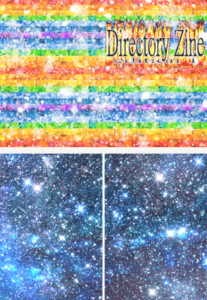Print is not dead, and those who create zines know this to be true. In the D.C. area, zines are an outlet for personal passion projects — and they continue to thrive in the region, decades after they proliferated during the height of the District’s punk music scene.
Zines — pronounced “zeens” like in “magazines” — are self-published works that are often produced in limited-run batches. Sometimes, they can be glossy and highly-illustrated, but other times they can be handwritten, hand-folded or stapled, while printed as cheaply as possible with Xerox machines. It’s impossible to pin down a singular example of what a zine can be because the medium can come in many forms and encompass endless topics and themes.
Since 2014, the D.C. Punk Archive in The People’s Archive at the D.C. Public Library has been collecting and archiving materials to protect the stories of the city’s influential punk music scene. Zines are one part of its varied collection and they’re an essential window to understanding the hyperlocal and personal stories from the past.
Lisa Warwick, manager of The People’s Archive at the D.C. Public Library, told WTOP, “We try to find zines and stories that really tell the story of what it’s like to live in D.C., and we try to collect from communities that maybe don’t feel heard or seen by traditional publications.”
While a large portion of the zine library dates between the early 1980s through the 1990s, The People’s Archive often accepts zines made in the current day from local zinesters, or creators of zines. Elizabeth von Oehsen, founder and art director of PaperJam, is one of the zinesters whose work is archived in the collection.
Von Oehsen’s PaperJam zine focuses on contemporary D.C. music culture. In each of the five issues, readers can find interviews and artworks alongside lists of new songs by D.C.-area bands as well as lists of local nonprofits, donation opportunities and volunteer events to support.
Von Oehsen said it was the D.C. Public Library’s zine archive that inspired her to create her own. “It really pushed me to want to make one on my own,” she told WTOP.
“It’s really liberating to make a zine as an individual,” said von Oehsen.
Because they’re self-published, zines have the potential to be experimental in their form, informal and personal in their writings and even genre-bending.
For Caleb Yoshida and Sabrina Li, co-founders of the Directory zine, they used their first issue to provide a platform for experimental artists from underrepresented backgrounds.

In the editor’s letter of the Directory zine is a “love letter” to Grimace, the purple anthropomorphic taste bud from McDonald’s. Later in the zine, there is a photo of a kitchen with the sentence, “I never did catch a glimpse of myself coming out of the water,” and another photo of what appears to be a lake at dusk with the words, “I was so hopeful that I would find out what really happened to me,” overtop. The poetry inside is sometimes scribbled, appearing handwritten along with one case of a blackout poem. One of the glitch artworks featured is a frame from the Japanese anime television series, “Ghost in the Shell,” that has been purposely corrupted.
On what inspired the two to create their zine, it was based on the potential impact that zines can have on one’s community.
“Zines have a long history of being countercultural and revolutionary and being associated with social movements and different change and so their greatest strength is to create movements and communities and to organize people surrounding the ideas they convey,” said Yoshida. “In our case, we would like to see more and more people getting on board with what we think is important, which is to create a more inclusive, more diverse and more varied art space.”
The University of Maryland gifted Yoshida and Li a grant for them to be able to create and print their zine. The university’s library also has archived approximately 500 print zines and has digitized more than 1,000 zines, according to John Davis, the curator of special collections in performing arts at the University of Maryland. Davis is a zine creator, historian and author of an upcoming book for Georgetown University Press on the D.C.’s fanzine history from the mid-1970s into the 21st century.
For Mouna Touré, she similarly saw the appeal of the accessibility of zines and their ability to be an outlet for her to collaborate with other artists and writers. Touré is a zine creator and founder of BlackLight Sugar Press. She is also a librarian at Chantilly Regional Library who organizes art- and zine-focused events there.
In her autobiographical zine comic, ADDress, Touré shared her perspective about the experiences she has had with attention-deficit/hyperactivity disorder. “It’s a zine I made for catharsis, and a bit of self-positivity,” she told WTOP. “I ended up making that zine just to sort of analyze my own life and things about myself related to my ADHD that I actually enjoy about myself.”
With this, Touré said, “Zines can be made by anyone, for anyone and can be about anything.”
The biggest zine-focused event in the D.C. region is D.C. Zinefest, a one-day independent event designed to provide a space for zine-makers, self-published artists and writers. One of the organizers, Dirk Keaton, said that attendance for the event in 2022 had over 1,200 guests. This year, at their upcoming, bigger, not-yet-declared location, the event on Nov. 18 will host approximately 75 zinesters.
Some bookstores around the region stock zines in their stores to support small creators. At People’s Book in D.C.’s Takoma neighborhood, co-owner Matt Bormet told WTOP that the store’s zine section features “voices you’ve never heard of on topics you might not have known you were really interested in” with writers and illustrators from around the globe.

On what people may find appealing about smaller print publications like zines, Bormet said, “When you put something in a paperback form, if it’s a physical copy of something, that’s not going to go away. You can keep that in your attic or in your drawer, and in 20 years, go back and look at it and say, ‘Hey, this is really cool.’ Anything you put on the internet disappears in five years, and in 10 years, you’ll never ever find it again.”
Fantom Comics in Dupont Circle is another notable bookstore for buying zines. The store also sometimes hosts zine reading and creating events.
“No one gets rich making or selling zines … Really, they’re there to help build the community because that’s incredibly important to us,” said Jacob Shapiro, co-manager and co-owner of Fantom Comics.
“It’s very low-stakes … No one’s expecting much because they’re all aware that this is something we’re doing for fun, most of the time for free,” said Fantom Comics co-manager Sarahti Gassmalla, who believes the zine culture in the District is “absolutely thriving.”








